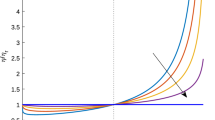Abstract
The n-species totally asymmetric zero range process (n-TAZRP) on a one-dimensional periodic chain studied recently by the authors is a continuous time Markov process where arbitrary number of particles can occupy the same sites and hop to the adjacent sites only in one direction with a priority constraint according to their species. In this paper we introduce an n-parameter generalization of the n-TAZRP having inhomogeneous transition rate. The steady state probability is obtained in a matrix product form and also by an algorithm related to combinatorial R.
Similar content being viewed by others
Notes
The enumeration of particles is reversed from [16] where the smaller species ones had the priority.
Here and in what follows, a multiset (set accounting for multiplicity of elements), say \(\{1,1,3,5,6\}\), is abbreviated to 11356, which does not cause a confusion since all the examples in this paper shall be concerned with the case \(n\le 9\).
We write \(A_{(\mu ),(\alpha ^1,\alpha ^2)}\) for example simply as \(A_{\mu ,\alpha ^1\alpha ^2}\).
The convention of labeling the particle species here is opposite from [16] causing many changes.
The notation \(\Phi _{\mathbf{x}^a}\) is slightly incomplete in that the a-dependence becomes invisible when \(\mathbf{x}^a\) is written generally as \(\mathbf{y}\) for example. However we prefer it for simplicity. A proper alternative is to formulate it as a map \(S(m_1,\ldots , m_{a-1})\times B_{\ell _a}\; \longrightarrow S(m_1,\ldots , m_a)\). A similar caution applies to \(\varpi _{\mathbf{x}^a}\).
This is an abbreviation of \((\emptyset , \{1,3\}, \{2\}, \{3\}, \emptyset , \{1,2\}, \{1,1\})\) as in Example 2.1.
The arbitrariness of the choice does not spoil the well-definedness. See Remark 4.2 (i).
Hence every line starts from a particle with the shape \(\lceil \) rather than \(\rfloor \).
Possible incoming H-lines originating from the NE neighbor box have not been drawn here for simplicity but are included in the argument.
References
Andjel, E.D.: Invariant measures for the zero range process. Ann. Probability 10, 525–547 (1982)
Ayyer, A., Linusson, S.: An inhomogeneous multispecies TASEP on a ring. Adv. Appl. Math. 57, 21–43 (2014)
Arita, C., Kuniba, A., Sakai, K., Sawabe, T.: Spectrum in multi-species asymmetric simple exclusion process on a ring. J. Phys. A 42, 345002 (2009)
Arita, C., Mallick, K.: Matrix product solution to an inhomogeneous multi-species TASEP. J. Phys. A 46, 085002 (2013)
Baxter, R.J.: Exactly solved models in statistical mechanics. Dover, London (2007)
Drinfeld, V.G..: Quantum groups. In: Proceedings of the International Congress of Mathematicians, Vol. 1, 2, pp. 798–820. (Berkeley, Calif., 1986), Amer. Math. Soc., Providence (1987)
Evans, M.R., Hanney, T.: Nonequilibrium statistical mechanics of the zero-range process and related models. J. Phys. A 38, R195–R240 (2005)
Ferrari, P.A., Martin, J.B.: Stationary distributions of multi-type totally asymmetric exclusion processes. Ann. Probability 35, 807–832 (2007)
Großkinsky, S., Schütz, G.M., Spohn, H.: Condensation in the zero range process: stationary and dynamical properties. J. Stat. Phys. 113, 389–410 (2003)
Jimbo, M.: A \(q\)-difference analogue of \(U({\mathfrak{g}})\) and the Yang–Baxter equation. Lett. Math. Phys. 10, 63–69 (1985)
Kashiwara, M.: On crystal bases of \(q\)-analogue of universal enveloping algebras. Duke Math. J. 63, 465–516 (1991)
Kipnis, C., Landim, C.: Scaling limits of interacting particle systems, Grundlehren der mathematischen. Springer, Heidelberg (1999)
Kuniba, A., Okado, M., Sakamoto, R., Takagi, T., Yamada, Y.: Crystal interpretation of Kerov–Kirillov–Reshetikhin bijection. Nucl. Phys. B 740, 299–327 (2006)
Kuniba, A., Maruyama, S., Okado, M.: Multispecies TASEP and combinatorial R. J. Phys. A 48, 34FT02 (2015)
Kuniba, A., Maruyama, S., Okado, M.: Multispecies TASEP and the tetrahedron equation. J. Phys. A 49, 114001 (2016)
Kuniba, A., Maruyama, S., Okado, M.: Multispecies totally asymmetric zero range process: I. Multiline process and combinatorial \(R\). J. Integrable systems. arXiv:1511.09168
Kuniba, A., Maruyama, S. Okado, M.: Multispecies totally asymmetric zero range process: II. Hat relation and tetrahedron equation, in preparation
Kuniba, A., Okado, M., Sergeev, S.: Tetrahedron equation and generalized quantum groups. J. Phys. A 48, 304001 (2015)
Lam, T., Williams, L.: A Markov chain on the symmetric group which is Schubert positive? arXiv:1102.4406
Nakayashiki, A., Yamada, Y.: Kostka polynomials and energy functions in solvable lattice models. Selecta Mathematica New Ser. 3, 547–599 (1997)
Prolhac, S., Evans, M.R., Mallick, K.: The matrix product solution of the multispecies partially asymmetric exclusion process. J. Phys. A 42, 165004 (2009)
Spitzer, F.: Interaction of Markov processes. Adv. Math. 5, 246–290 (1970)
Tracy, C.A., Widom, H.: On the asymmetric simple exclusion process with multiple species. J. Stat. Phys. 150, 457–470 (2013)
Zamolodchikov, A.B.: Tetrahedra equations and integrable systems in three-dimensional space. Soviet Phys. JETP 79, 641–664 (1980)
Acknowledgments
This work is supported by Grants-in-Aid for Scientific Research No. 15K04892, No. 15K13429 and No. 23340007 from JSPS.
Author information
Authors and Affiliations
Corresponding author
Appendix
Appendix
Let us show the equality of the coefficients of \(w_n^3\) in (3.7). In the left hand side, it is given by
where we used \({\bar{\alpha }}={\bar{\gamma }} \iff {\bar{\beta }}={\bar{\delta }}\) due to the conservation law. In the right hand side of (3.7), the coefficient of \(w_n^3\) is
coinciding with the above.
Rights and permissions
About this article
Cite this article
Kuniba, A., Maruyama, S. & Okado, M. Inhomogeneous Generalization of a Multispecies Totally Asymmetric Zero Range Process. J Stat Phys 164, 952–968 (2016). https://doi.org/10.1007/s10955-016-1555-3
Received:
Accepted:
Published:
Issue Date:
DOI: https://doi.org/10.1007/s10955-016-1555-3



